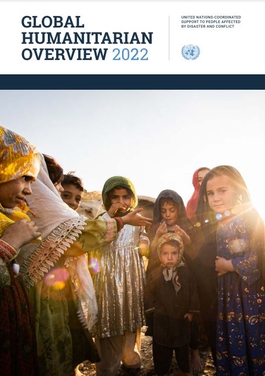
Humanitarian aid is material and logistic assistance to people who need help. It is usually short-term help until the long-term help by the government and other institutions replaces it. Among the people in need are the homeless, refugees, and victims of natural disasters, wars, and famines. Humanitarian relief efforts are provided for humanitarian purposes and include natural disasters and human-made disasters. The primary objective of humanitarian aid is to save lives, alleviate suffering, and maintain human dignity. It may, therefore, be distinguished from development aid, which seeks to address the underlying socioeconomic factors which may have led to a crisis or emergency. There is a debate on linking humanitarian aid and development efforts, which was reinforced by the World Humanitarian Summit in 2016. However, the conflation is viewed critically by practitioners.

A humanitarian crisis is defined as a singular event or a series of events that are threatening in terms of health, safety or well-being of a community or large group of people. It may be an internal or external conflict and usually occurs throughout a large land area. Local, national and international responses are necessary in such events.
An international non-governmental organization (INGO) is an organization which is independent of government involvement and extends the concept of a non-governmental organization (NGO) to an international scope.
The Tsunami Evaluation Coalition (TEC) was a unique learning and accountability initiative in the relief and development sector. It was first established in February 2005 to carry out joint evaluations of the response to the Asian earthquake and tsunamis of 26 December 2004.
There are a number of meanings for the term humanitarian. Here, humanitarian pertains to the practice of saving lives and alleviating suffering. It is usually related to emergency response whether in the case of a natural disaster or a man-made disaster such as war or other armed conflict. Humanitarian principles govern the way humanitarian response is carried out.

Humanitarian Accountability Partnership International, established in 2003, was the humanitarian sector's first international self-regulatory body. A multi-agency initiative working to improve the accountability of humanitarian action to people affected by disasters and other crises, HAP members ranged from organisations with a mandate for emergency relief and development activities to institutional donors. The organisation aimed to strengthen accountability towards those affected by crisis situations and to facilitate improved performance within the humanitarian sector. The ultimate goal of the organisation was to uphold the rights and the dignity of crisis-affected populations across the world.
The Inter-Agency Standing Committee (IASC) is an inter-agency forum of United Nations and non-UN humanitarian partners founded in 1991 to strengthen humanitarian assistance. The overall objective of the IASC is to improve the delivery of humanitarian assistance to affected populations. The Committee was established following UN General Assembly Resolution 46/182 and resolution 48/57 confirmed that it should be the primary method for inter-agency coordination. The committee is chaired by the Emergency Relief Coordinator.

ALNAP is a UK based non-profit organization that works to increase learning and accountability in the humanitarian aid sector.
Humanitarian Initiative Just Relief Aid (HIJRA) is an African humanitarian organization focused on the implementation of emergency and resilience programming in the greater Horn of Africa; Somalia, Kenya and Uganda.
The Emergency Capacity Building Project is a collaborative capacity-building project aimed at improving the speed, effectiveness and delivery of humanitarian response programs. The ECB Project is a partnership between seven non-governmental organizations (NGOs), and implements programs in one region and four countries known as consortia.

The United Nations World Humanitarian Summit (WHS) was held in Istanbul, Turkey, on May 23 and 24, 2016. The summit was an initiative of the Secretary-General of the United Nations Ban Ki-moon and was organized by the United Nations Office for the Coordination of Humanitarian Affairs.
The Aid Worker Security Database (AWSD) is a project of the international research group Humanitarian Outcomes. Funded by USAID, it records major incidents, from 1997 to present, of attacks on humanitarian workers worldwide. As cited in the New York Times, "it is widely regarded as an authoritative reference for aid organisations and governments in assessing trends in security threats." Since its inception in 2005 as the first fully comprehensive compilation of this data, the AWSD has been a source of quantitative evidence on matters related to the security of humanitarian operations in conflict, referenced in policy debates and cited in official United Nations statements, United Nations General Assembly resolutions, United Nations Security Council documents, and reports of the Secretary-General of the United Nations.
Ben Ramalingam is a British researcher, strategist, innovator and author, currently Director of Strategy at British Red Cross, senior research associate at the Overseas Development Institute Politics and Governance programme and advisor to the OECD Development Assistance Committee on innovation investments for development, humanitarian and human rights issues.

The Grand Bargain: Agenda for Humanity, usually called the Grand Bargain, is an agreement to reform the delivery of humanitarian aid, that was struck at the World Humanitarian Summit in May 2016. The agreement contains 51 specific commitments, grouped into ten focus areas, with activity targets to be completed by January 1, 2020.

Localisation is the practice, in humanitarian aid, to give more decision making power and funding to organizations and people that are based in countries affected by humanitarian emergencies.

The Network for Empowered Aid Response, often called the NEAR Network, is a group of humanitarian civil society organisations based in Africa, Asia, and the Middle East.

The Humanitarian Cluster System is a system, used by the United Nations Office for the Coordination of Humanitarian Affairs, to coordinate multi-agency responses to large humanitarian emergencies.

Global Humanitarian Overview is an annual report published by the United Nations Office for the Coordination of Humanitarian Affairs.
Degan Ali is the Somali-American humanitarian consultant and the executive director of Adeso.
Humanitarian protection is the act of promoting and ensuring the legal rights of people affected by humanitarian crises.









